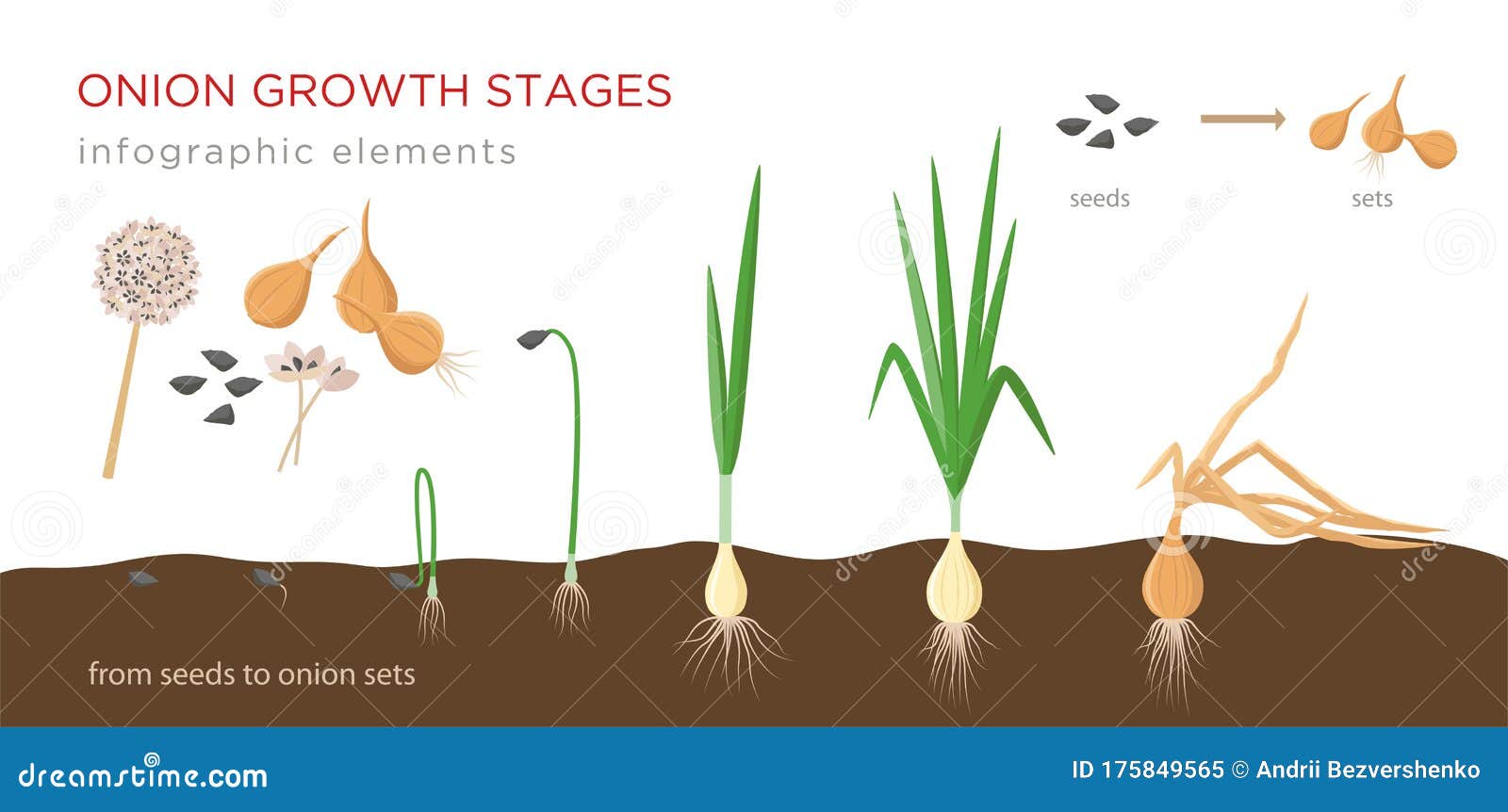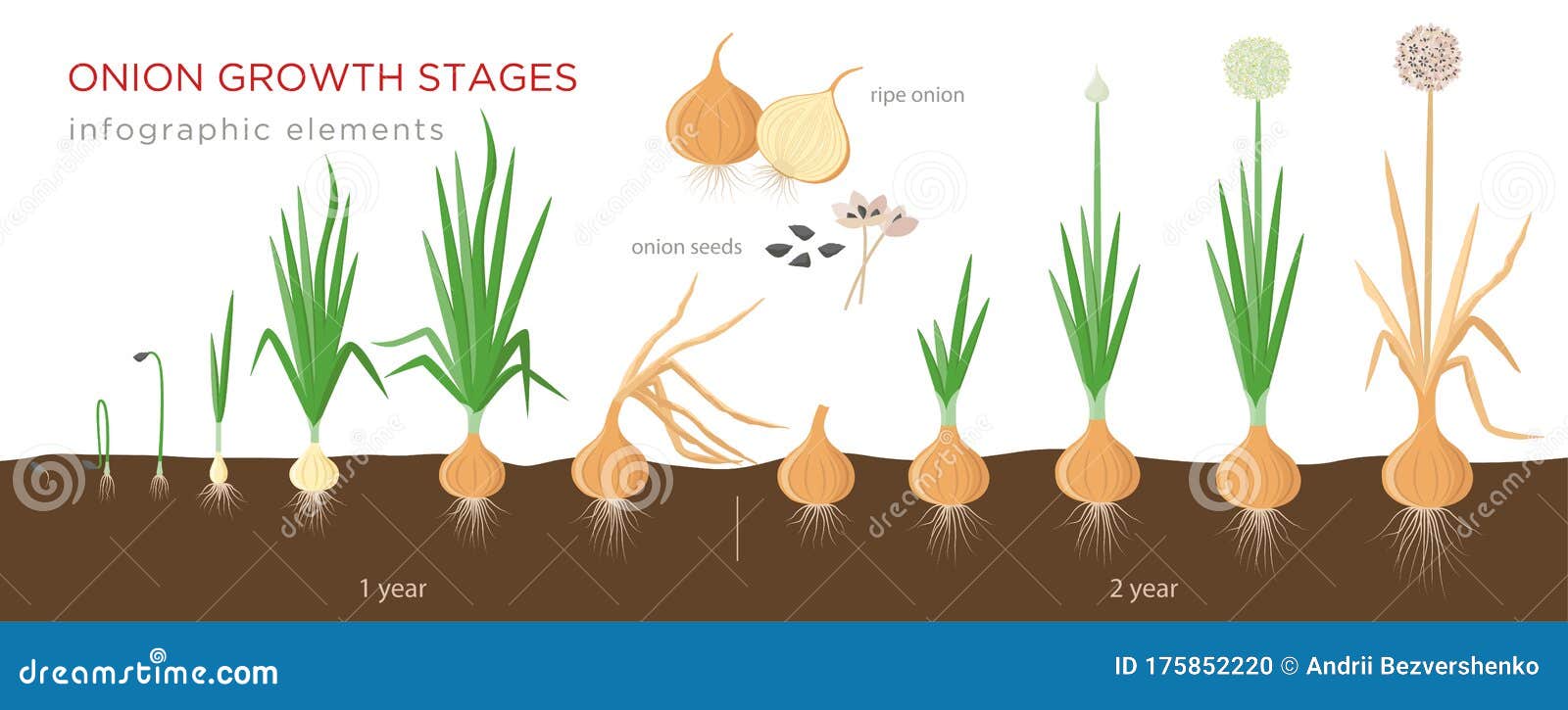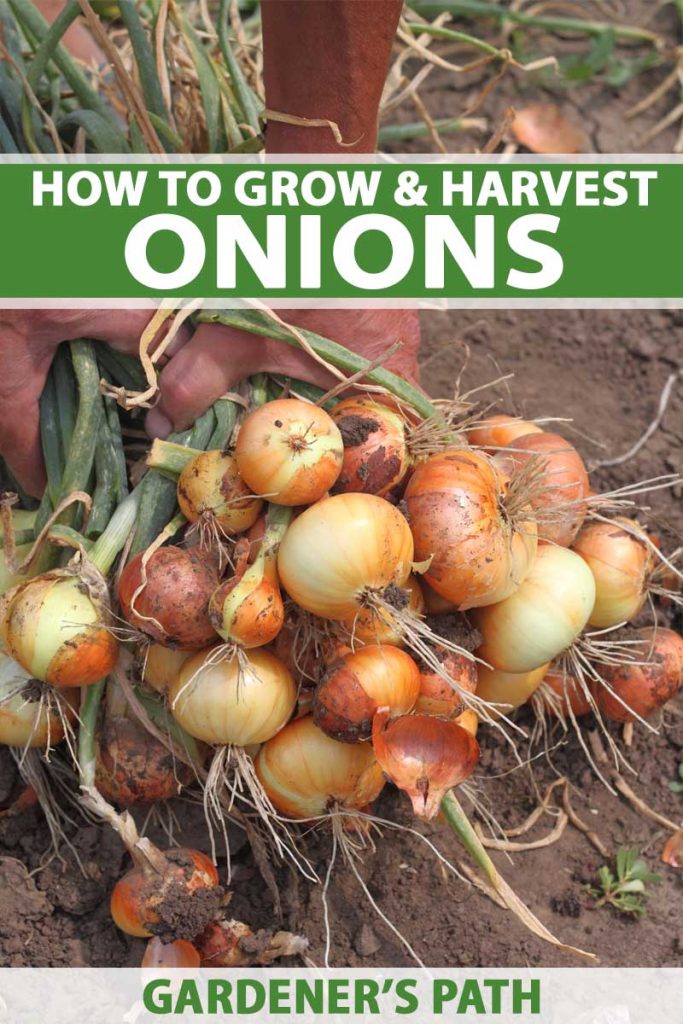Understanding the Onion Growth Cycle
Onion growth is a complex process that involves multiple stages, from seed germination to maturity. The entire process can take anywhere from 90 to 120 days, depending on factors such as climate, soil, and light exposure. To understand how long it takes for onions to grow, it’s essential to break down the growth cycle into its distinct stages.
The onion growth cycle begins with seed germination, which typically occurs within 7-10 days after sowing. During this stage, the seed absorbs water, and the embryo begins to grow. The seedling then emerges, and the first set of leaves, known as the cotyledons, appear.
As the seedling grows, it develops its root system and begins to produce true leaves. This stage is critical, as it lays the foundation for the onion’s future growth. The seedling requires adequate light, water, and nutrients to develop a strong root system and healthy leaves.
After 30-40 days, the onion begins to form a bulb. This stage is characterized by the formation of concentric rings, which eventually become the onion’s layers. The bulb grows in size and maturity over the next 60-90 days, depending on the variety and growing conditions.
Factors such as climate, soil, and light exposure play a significant role in determining how long it takes for onions to grow. For example, onions grown in cooler climates with well-draining soil tend to mature faster than those grown in warmer climates with poor soil quality.
By understanding the onion growth cycle and the factors that influence it, growers can optimize their growing conditions to achieve the best possible results. Whether you’re a seasoned gardener or a beginner, knowing how long it takes for onions to grow can help you plan and manage your crop more effectively.
How to Create the Perfect Environment for Onion Growth
Creating an ideal environment for onion growth is crucial for achieving optimal results. Onions require a specific set of conditions to thrive, including well-draining soil, adequate temperature, and sufficient moisture. By understanding these requirements, growers can create a perfect environment for their onions to grow.
Soil preparation is a critical step in creating an ideal environment for onion growth. Onions prefer well-draining, fertile soil with a pH between 6.0 and 7.0. To achieve this, growers can add organic matter such as compost or manure to the soil. This will help to improve the soil’s structure and fertility, creating a perfect environment for onion growth.
Temperature control is also essential for onion growth. Onions prefer cooler temperatures, typically between 60°F and 70°F (15°C and 21°C). Growers can use techniques such as mulching or shading to regulate soil temperature and create a perfect environment for onion growth.
Moisture management is another critical aspect of creating an ideal environment for onion growth. Onions require consistent moisture, especially during the bulb formation stage. Growers can use techniques such as drip irrigation or soaker hoses to deliver water directly to the roots, reducing evaporation and runoff.
Crop rotation and companion planting are also important considerations when creating an ideal environment for onion growth. Onions can be grown in rotation with other crops such as garlic, carrots, and beets. Companion planting with herbs such as basil and mint can also help to repel pests and improve growth.
By creating an ideal environment for onion growth, growers can optimize their chances of success. Whether you’re a seasoned gardener or a beginner, understanding the specific requirements of onions can help you to create a perfect environment for growth and achieve optimal results.
The Role of Light and Temperature in Onion Growth
Light and temperature are two critical factors that affect onion growth. Onions require a specific amount of light and temperature to grow optimally, and understanding these requirements is essential for achieving the best possible results.
Light is essential for onion growth, as it provides the energy needed for photosynthesis. Onions require a minimum of 12 hours of daylight to grow, and the intensity of the light can affect the growth rate. For example, onions grown in areas with high light intensity tend to grow faster than those grown in areas with low light intensity.
Temperature also plays a crucial role in onion growth. Onions prefer cooler temperatures, typically between 60°F and 70°F (15°C and 21°C), during the early stages of growth. As the onions mature, they can tolerate warmer temperatures, but extreme temperatures can affect growth and quality.
The optimal light and temperature requirements for onions vary depending on the stage of growth. During the seed germination stage, onions require a consistent temperature of around 70°F (21°C) and high light intensity. As the seedlings grow, they require a slightly cooler temperature and moderate light intensity.
During the bulb formation stage, onions require a consistent temperature of around 60°F (15°C) and low light intensity. This allows the onions to focus their energy on forming a large, healthy bulb.
Understanding the role of light and temperature in onion growth can help growers optimize their growing conditions and achieve the best possible results. By providing the right amount of light and temperature, growers can promote healthy growth, prevent disease, and increase yields.
For example, growers can use techniques such as shading or mulching to regulate soil temperature and provide the optimal amount of light for onion growth. By doing so, they can create an ideal environment for their onions to grow and thrive.
Onion Varieties: Choosing the Right Type for Your Climate
With over 700 varieties of onions to choose from, selecting the right type for your climate and growing conditions can be a daunting task. Onions are classified into several categories, including sweet onions, storage onions, and scallions, each with its unique characteristics and growth habits.
Sweet onions, such as Vidalia and Maui, are known for their sweet, mild flavor and are typically grown in warm, dry climates. These onions are ideal for fresh market sales and are often harvested in the summer months.
Storage onions, such as Yellow Granex and Texas Grano, are designed for long-term storage and are typically grown in cooler, more temperate climates. These onions are ideal for cooking and are often harvested in the fall months.
Scallions, also known as green onions, are harvested before the bulb forms and are often used in salads and as a garnish. These onions are ideal for growing in containers and can be harvested in as little as 60 days.
When choosing an onion variety, it’s essential to consider the climate and growing conditions in your area. Onions require a certain amount of chill hours, or hours below 40°F (4°C), to form a bulb. In warmer climates, onions may not receive enough chill hours, resulting in a smaller or deformed bulb.
In addition to climate, soil quality and moisture levels also play a crucial role in onion growth. Onions prefer well-draining, fertile soil with a pH between 6.0 and 7.0. In areas with poor soil quality, onions may require additional fertilization or soil amendments.
By choosing the right onion variety for your climate and growing conditions, you can optimize your chances of success and achieve a bountiful harvest. Whether you’re a seasoned gardener or a beginner, understanding the different types of onion varieties and their unique characteristics can help you make informed decisions and achieve optimal results.
How Long Does it Take for Onions to Grow: A General Overview
The length of time it takes for onions to grow can vary depending on several factors, including the type of onion, climate, soil quality, and weather conditions. On average, onions take around 120 to 150 days to mature from seed to harvest.
The onion growth cycle can be broken down into several stages, including seed germination, seedling establishment, bulb formation, and maturity. Each stage has its own unique characteristics and growth requirements.
Seed germination typically occurs within 7-10 days after sowing, and the seedlings emerge with their first set of leaves. The seedling establishment stage lasts around 2-3 weeks, during which the seedlings develop their root system and produce their first true leaves.
The bulb formation stage is the longest stage of the onion growth cycle, lasting around 60-90 days. During this stage, the onion bulb forms and grows in size, and the plant produces its characteristic flavor and texture.
The final stage of the onion growth cycle is maturity, which occurs when the onion bulb is fully formed and the tops of the plants begin to yellow and fall over. This stage typically lasts around 1-2 weeks.
Weather conditions, such as temperature, rainfall, and sunlight, can affect the growth rate of onions. For example, onions grown in areas with high temperatures and low rainfall may mature faster than those grown in areas with cooler temperatures and higher rainfall.
Soil quality is also an important factor in onion growth. Onions prefer well-draining, fertile soil with a pH between 6.0 and 7.0. Soil with poor drainage or low fertility can lead to reduced growth rates and lower yields.
By understanding the factors that affect onion growth, growers can optimize their growing conditions and achieve the best possible results. Whether you’re a seasoned gardener or a beginner, knowing how long it takes for onions to grow can help you plan and manage your crop more effectively.
Stages of Onion Growth: From Seed to Harvest
The onion growth cycle can be broken down into several distinct stages, each with its own unique characteristics and growth requirements. Understanding these stages is crucial for optimizing onion growth and achieving a bountiful harvest.
Stage 1: Seed Germination (7-10 days)
The onion growth cycle begins with seed germination, which typically occurs within 7-10 days after sowing. During this stage, the seed absorbs water, and the embryo begins to grow. The seedling emerges with its first set of leaves, known as the cotyledons.
Stage 2: Seedling Establishment (2-3 weeks)
After germination, the seedling establishes itself and develops its root system. The seedling produces its first true leaves, which are larger and more developed than the cotyledons. During this stage, the seedling is vulnerable to pests and diseases, so it’s essential to provide optimal growing conditions.
Stage 3: Bulb Formation (60-90 days)
As the seedling grows, it begins to form a bulb. This stage is characterized by the formation of concentric rings, which eventually become the onion’s layers. The bulb grows in size and maturity over the next 60-90 days, depending on the variety and growing conditions.
Stage 4: Maturity (1-2 weeks)
The final stage of the onion growth cycle is maturity, which occurs when the onion bulb is fully formed and the tops of the plants begin to yellow and fall over. This stage typically lasts around 1-2 weeks, during which the onion is ready for harvest.
By understanding the different stages of onion growth, growers can optimize their growing conditions and achieve the best possible results. Whether you’re a seasoned gardener or a beginner, knowing the stages of onion growth can help you plan and manage your crop more effectively.
Tips for Optimal Growth:
Provide optimal growing conditions, including well-draining soil, adequate moisture, and sufficient sunlight.
Use crop rotation and companion planting to reduce pests and diseases.
Monitor the onion growth cycle and adjust growing conditions as needed.
Harvest the onions at the right time to ensure optimal flavor and texture.
Common Challenges and Solutions for Growing Onions
Onion growers may face several challenges that can affect the quality and quantity of their harvest. Some common challenges include pests, diseases, and nutrient deficiencies. In this section, we will discuss some of the most common challenges and provide solutions and tips for overcoming them.
Pests:
Onions are susceptible to several pests, including aphids, thrips, and onion maggots. These pests can cause damage to the leaves and bulbs, reducing the quality and quantity of the harvest. To control pests, growers can use integrated pest management (IPM) techniques, such as crop rotation, biological control, and chemical control.
Diseases:
Onions are also susceptible to several diseases, including fungal diseases such as powdery mildew and downy mildew, and bacterial diseases such as bacterial leaf spot. These diseases can cause damage to the leaves and bulbs, reducing the quality and quantity of the harvest. To control diseases, growers can use IPM techniques, such as crop rotation, sanitation, and fungicides.
Nutrient Deficiencies:
Onions require several nutrients to grow, including nitrogen, phosphorus, and potassium. Nutrient deficiencies can affect the quality and quantity of the harvest. To prevent nutrient deficiencies, growers can use soil testing to determine the nutrient levels in the soil and apply fertilizers as needed.
Solutions and Tips:
Use crop rotation to reduce the risk of pests and diseases.
Use biological control methods, such as introducing beneficial insects, to control pests.
Use fungicides and bactericides to control diseases.
Use soil testing to determine the nutrient levels in the soil and apply fertilizers as needed.
Monitor the onion growth cycle and adjust growing conditions as needed.
By understanding the common challenges and solutions for growing onions, growers can take steps to prevent and control pests, diseases, and nutrient deficiencies, and achieve a bountiful and healthy harvest.
Maximizing Your Onion Harvest: Tips and Tricks
Maximizing your onion harvest requires careful planning, attention to detail, and a few expert tips and tricks. In this section, we will provide you with the knowledge and expertise you need to get the most out of your onion crop.
Proper Care:
To maximize your onion harvest, it’s essential to provide your onions with the proper care. This includes ensuring they receive adequate water, nutrients, and sunlight. Onions require about 1-2 inches of water per week, either from rainfall or irrigation. They also benefit from regular fertilization, especially during the bulb formation stage.
Preventing Bolting:
Bolting is a common problem that can affect onion crops, especially during periods of stress or extreme weather conditions. To prevent bolting, it’s essential to provide your onions with a consistent and stable environment. This includes maintaining a consistent temperature, ensuring adequate moisture, and providing support for the plants as they grow.
Storing Your Harvest:
Once your onions are harvested, it’s essential to store them properly to maintain their freshness and quality. Onions can be stored in a cool, dry place, such as a basement or root cellar. They can also be stored in a breathable container, such as a mesh bag or a paper bag with holes.
Tips and Tricks:
Use a mulch to retain moisture and suppress weeds.
Use a drip irrigation system to deliver water directly to the roots.
Use a fertilizer specifically formulated for onions.
Monitor your onions regularly for signs of stress or disease.
Harvest your onions at the right time to ensure optimal flavor and texture.
By following these tips and tricks, you can maximize your onion harvest and enjoy a bountiful and delicious crop.



/growing-onions-1403447-01-38d480a2d16d4ea0b0dd174f42785e1d.jpg)




